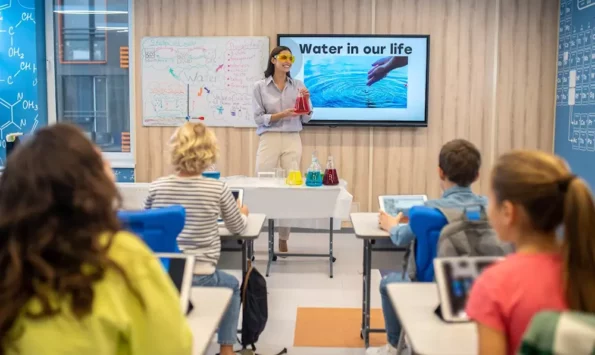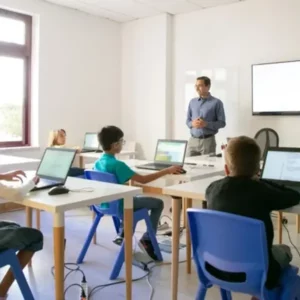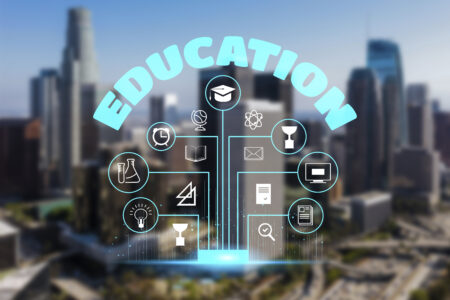
Discover the power of tech-savvy classrooms in bridging the education gap. Explore how integrating technology in education such as smartboard enhances engagement, personalized learning, and real-world relevance. Learn about the benefits, implementation strategies, and challenges of creating a digital-rich learning environment. Unlock the potential of students with tech-savvy classrooms.
Introduction
Education is the cornerstone of personal and societal development. As technology continues to advance at an unprecedented pace, it is imperative that classrooms adapt to these changes to provide students with the best possible learning experience. In this article, we will explore the concept of tech-savvy classrooms and how they can bridge the education gap. By leveraging innovative technologies and embracing digital resources, educational institutions can empower students with the skills and knowledge needed to thrive in the modern world.
Embracing Technological Advancements in Education
The Role of Technology in Education
Technology has revolutionized various aspects of our lives, and education is no exception. Tech-savvy classrooms harness the power of technology to enhance teaching and learning methodologies. By integrating technology into the curriculum, educators can create interactive and engaging lessons that cater to the diverse learning styles of students. From multimedia presentations to online collaboration tools, technology opens up a world of possibilities in the realm of education.
Benefits of Tech-Savvy Classrooms
Tech-savvy classrooms offer numerous benefits that contribute to bridging the education gap:
- Enhanced Engagement: Technology enables educators to deliver lessons in an interactive and dynamic manner, capturing students’ attention and fostering active participation.
- Personalized Learning: Digital tools and software can adapt to individual learning needs, providing personalized learning experiences that cater to each student’s strengths and weaknesses.
- Access to Information: The internet provides a vast repository of knowledge, allowing students to explore and access information beyond the traditional confines of textbooks.
- Collaboration and Communication: Online platforms and tools facilitate collaboration and communication among students, enabling them to work together on projects, share ideas, and learn from one another.
- Real-World Relevance: By integrating technology, educators can bridge the gap between theoretical concepts and real-world applications, preparing students for the challenges of the modern workforce.
Implementing Tech-Savvy Classrooms
Infrastructure and Resources
To create effective tech-savvy classrooms, educational institutions need to invest in the necessary infrastructure and resources:
- Reliable Internet Connectivity: High-speed internet access is essential for seamless integration of technology in the classroom. Schools should ensure robust connectivity throughout their premises.
- Hardware and Devices: Equipping classrooms with devices such as computers, tablets, and interactive whiteboards empowers both educators and students to leverage technology effectively.
- Software and Applications: Educational software and applications offer a wide range of tools and resources that support teaching and learning processes. Schools should carefully select and integrate appropriate software into their curriculum.
Teacher Training and Professional Development

To maximize the benefits of tech-savvy classrooms, educators must receive adequate training and professional development opportunities:
- Technology Integration Workshops: Schools should organize workshops and training sessions to familiarize teachers with the latest educational technologies and how to integrate them effectively into their teaching practices.
- Collaborative Learning Communities: Creating a supportive network of educators who share best practices and innovative teaching ideas can help facilitate the successful implementation of tech-savvy classrooms.
- Continuous Learning: Educational institutions should encourage teachers to engage in continuous learning and professional development to stay updated with emerging technologies and pedagogical approaches.
Overcoming Challenges and Concerns
While tech-savvy classrooms offer immense potential, there are challenges and concerns that need to be addressed:
- Access and Equity: Ensuring equal access to technology and digital resources is crucial to prevent furthering the education gap. Schools should implement measures to provide resources to students from diverse socioeconomic backgrounds.
- Digital Literacy: Students and teachers alike need to develop digital literacy skills to effectively navigate and leverage technology for educational purposes. Schools should incorporate digital literacy programs into their curriculum.
- Privacy and Security: With the integration of technology comes the responsibility to protect student data and ensure privacy and security. Schools must implement robust cybersecurity measures and adhere to data protection regulations.
Conclusion
Tech-savvy classrooms have the potential to revolutionize education by bridging the education gap and equipping students with the skills needed in the digital age. By embracing technology, investing in infrastructure, providing professional development opportunities, and addressing concerns around access and equity, educational institutions can create an environment where students thrive and reach their full potential. As we move forward, it is imperative that we continue to explore innovative ways to leverage technology in education, preparing students for a future that demands technological literacy and adaptability.










